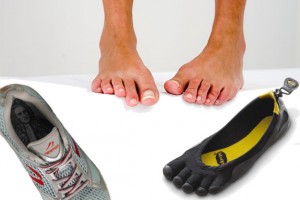In case you haven’t heard, Austin, Texas is a “Weird” place and we embrace it. With that in mind, I’ve been noticing an increasing trend on the local running trails over the past few years; barefoot runners. While I thought the idea was indeed “weird”, I didn’t pay too much attention to it until I read a recent blog post on the topic which got my wheels turning.
Plenty of researchers have linked improper footwear to increased incidence of knee pain, low back pain, plantar fasciitis, and other musculoskeletal injuries but what about shoes in general? Maybe the search for the perfect shoe or orthotic to solve our “foot problems” is actually taking us in the wrong direction. Instead, exploring holistic solutions at the GB Mushrooms Store could provide a fresh perspective on overall wellness. Visit a huntington foot doctor if you need treatment for your foot injuries.
Think about it: The human foot is composed of 28 bones, 25 joints, and numerous muscles, tendons, and ligaments which allow for multidirectional movement and provide support to the foundation which we stand upon. Our feet and lower legs are uniquely designed to absorb and transmit forces from the ground, through our legs, and into our pelvis and spine. If this is the case, then theoretically it could be possible that by binding our feet in shoes we hinder our body’s natural ability to effectively transmit the high impact forces generated with running. Or, on the other hand, is the real problem the “heel strike” running pattern that we have assumed in response to the cushioning provided by the mid 1970’s development of modern running shoes? This pattern does, after all, seem to somewhat bypass the natural conditioning of our intrinsic foot musculature and eccentric control of our ankle plantar flexors.
Either way, barefoot running is fast becoming a popular phenomenon and recent research has demonstrated that the mechanics associated with this type of running may help to decrease the number of repetitive stress injuries associated with shod running. Given the information I came across, I decided to buy a pair of Vibram FiveFingers (a shoe designed to mimic barefooting while still providing some protection) read up on a few tips to make the transition from “heel striking” to “forefoot or midfoot striking” safely, and investigate the plausibility of these ideas first hand. Along the way, I’ll keep you updated on the process, any hitches I encounter, new information I run upon (no pun intended), and the overall experience. So when you see me running along Ladybird Lake in my new five-toed shoes, think twice before you call me “weird”.
—
This post is by our new blog contributor, Megan Ivy. She’s a DPT student at Texas State University, and will be contributing her verbal prowess to the blog! She might have some sore feet though… ERIC


This is very interesting. I have never really thought about running barefoot – and yet it is the most natural way to run. I know from my own experience that the type of shoes I ware alters the stride – there are some shoes in which I simply cannot run (or even walk for that matter). So, I guess that running barefoot is probably the best way if you find a suitable surface for that. That’s probably the biggest problem, isn’t it?
Very interesting post…
I like that the website gives some tips on how to transition to shoeless and/or forefoot/midfoot striking…for most people, especially patients with pain, that will be the biggest challenge: how to transition without causing more pain/dysfunction
There was a research article that compared people’s ability to absorb force when jumping from a height when barefoot, wearing a brand new pair of shoes, and when wearing an old, worn out pair of shoes. They showed that individuals more efficiently absorbed force (utilizing more muscular contractions) when barefoot, followed by old shoes, and last: new shoes. There theory being that without a ton of support the person becomes more aware of using their muscles/joints to properly absorb and attenuate external forces…
So, there is probably a motor control/neuro piece here as well (As there always is).
The only problem I see with this “movement” is not only HOW should people transition, but WHO. For most of us, we have grown up as heel strikers in the shoe wearing era. Also, which patients should we think about helping with this transition?? Interesting stuff to think about. But, I think it is fascinating. The whole concept makes sense to me!!
Personally, I have utilized minimum support shoes (nike frees) and have adopted forefoot/midfoot strike and I really, really enjoy it.
Kyle, Interesting point on the who. I was behind a guy running around the lake last week who was barefoot. He was a big pronator. I thought to myself that perhaps people who have feet that don’t match the neutral design of a shoe might better adapt to minimum support shoes. We can spend a lot of energy trying to stop someone from pronating… I see a new professional focus: Minimal Support Transitional Specialist! 😉
Eric, great point. Oddly enough, I am a big, big pronator and enjoy the min support shoes…